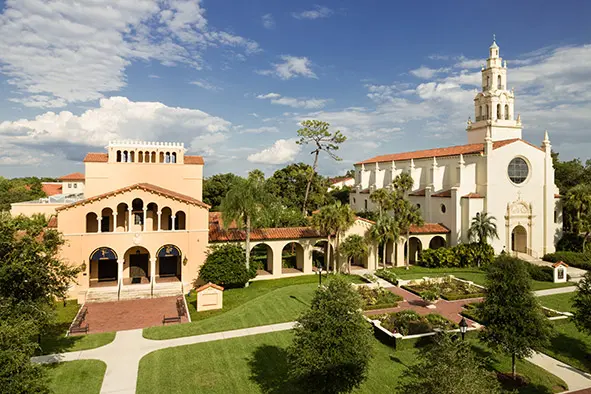In the early 1880s, Loring A. Chase and Oliver Chapman bought much of the land that would become Winter Park. Over the next few years a railroad station and several hotels were built, and Winter Park became a popular vacation destination for wealthy northerners.
Rollins College was built in 1885 by the Congregational Church. The college acquired its current emphasis on the liberal arts under the direction of Hamilton Holt, president of Rollins from 1925 through 1949.
Winter Park was incorporated in 1887.
Wealthy benefactors helped contribute to the growth of Winter Park into the twentieth century. Businessman Francis Knowles is remembered in the name of the chapel that is the centerpiece of Rollins College, entrepreneur Franklin Fairbanks has a major road named for him, and industrialist Charles Hosmer Morse is the namesake of a significant museum.
Artist and interior designer Jeannette McKean founded the Charles Hosmer Morse Museum of American Art in 1942 on the campus of Rollins College. The museum relocated to Welbourne Avenue before finding its permanent home in an expanded facility on the city’s main street, Park Avenue. Morse was McKean’s grandfather.
Jeannette McKean was married to Hugh F. McKean, a 1930 graduate of Rollins College and an art instructor there beginning in 1932. Hugh McKean served as president of Rollins from 1952 until 1969. He was also director of the Morse Museum from its founding until his death in May 1995. McKean died just two months before the grand opening of the greatly expanded museum.
Following his graduation from Rollins, McKean was awarded a fellowship to study with Louis Comfort Tiffany, who was a painter and stained glass artist. Tiffany was the son of the famous jewelry store founder.
“Mr. Tiffany believed very strongly that the more people you could reach with art, the better off everybody would be,” McKean remembered in a 1992 interview. “He thought that it was necessary to know art to live a complete life, or a satisfactory life.”
Tiffany’s Long Island estate, Laurelton Hall, was destroyed by a fire in 1957. Jeannette and Hugh McKean went there to save Tiffany’s artwork, bringing it back to Winter Park.
The Charles Hosmer Morse Museum of American Art has the most comprehensive collection of Tiffany’s work to be found anywhere. The collection includes stained glass windows, lamps, candlesticks, paintings, and the reconstructed Tiffany chapel from the 1883 World’s Fair.
A scenic boat tour departs from a dock on Morse Boulevard. The canals that connect lakes Virginia, Osceola, and Maitland were built by Winter Park’s founders to facilitate the transportation of logs and building materials. One of the most impressive estates that can be seen from the boat is the former home of sculptor Albin Polášek, which is now a museum housing many of the artist’s works. Polášek’s best known work, Man Carving His Own Destiny, depicts a male figure still partially embedded in stone, using tools to free himself from the rock.
John Tiedtke was another important figure in the cultural development of Winter Park. Tiedtke vacationed in Florida with his family in the 1920s. In the 1930s, he was very successful in the state’s sugar industry, and he moved to Winter Park in 1948.
The Winter Park Bach Festival was established in 1935. Tiedtke served as president of the event from 1950 until his death in 2004 at the age of 97.
“The Bach Festival was started by a very dynamic woman, a Mrs. Sprague-Smith, and she did a great job of creating it and getting it going,” Tiedtke remembered in a 1995 interview. “In 1950, she died suddenly. I was on the board, and nobody else on the board wanted the responsibility of trying to run it and keep it going, so I finally agreed to do it. Then, for two or three years, Hugh McKean, the president of Rollins, and I kept trying to find somebody to run it, and we couldn’t. He finally suggested that I just take the title of president because I’d been running it anyway.”
The Winter Park Bach Festival continues today, featuring a 160 voice choir and an orchestra performing a wide variety of classical music.
Winter Park remains a haven for culture in Florida.

